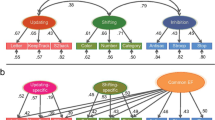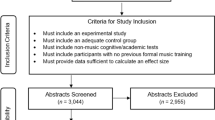Abstract
The current experiment investigated the extent to which three variables (autism severity, nonverbal intellectual functioning, and verbal intellectual functioning) are associated with over-selective responding in a group of children with Autism Spectrum Disorder. This paper also analyzed the association of these three variables with the recovery of responding to a previously under-selected stimulus following extinction of the previously over-selected stimulus. The results demonstrated that participants showed over-selectivity, and demonstrated that extinction of the over-selected stimulus led to recovery of responding to the previously under-selected stimulus. For both over-selectivity, and recovery from over-selectivity, verbal functioning appeared to predict the effects most strongly, with greater over-selectivity in the lower functioning individuals, and greater recovery in the higher functioning individuals.



Similar content being viewed by others
References
Allen, K. D., & Fuqua, R. W. (1985). Eliminating selective stimulus control: A comparison of two procedures for teaching mentally retarded children to respond to compound stimuli. Journal of Experimental Child Psychology, 39, 55–71.
Anderson, N. B., & Rincover, A. (1982). The generality of overselectivity in developmentally disabled children. Journal of Experimental Child Psychology, 34, 217–230.
Bailey, S. L. (1981). Stimulus overselectivity in learning disabled children. Journal of Applied Behavior Analysis, 14, 239–248.
Broomfield, L., McHugh, L., & Reed, P. (2008). Re-emergence of under-selected stimuli, after the extinction of over-selected stimuli in an automated match to samples procedure. Research in Developmental Disabilities, 29(6), 503–512.
Chiang, H., & Carter, M. (2008). Spontaneity of communication in individuals with autism. Journal of Autism and Developmental Disorders, 38, 693–705.
Cronbach, L. J. (1951). Coefficient alpha and the internal structure of tests. Psychometrika, 16, 297–334.
Dube, W. V. (2009). Stimulus overselectivity in discrimination learning. In P. Reed (Ed.), Behavioral theories and interventions for autism (pp. 23–46). New York: Nova Science Publishers.
Dube, W. V., Lombard, K. M., Farren, K. M., Flusser, D., Balsamo, L. M., & Fowler, T. R. (1999). Eye tracking assessment of stimulus overselectivity in individuals with mental retardation. Experimental Analysis of Human Behavior Bulletin, 13, 267–271.
Dube, W. V., & McIlvane, W. J. (1999). Reduction of stimulus overselectivity with nonverbal differential observing responses. Journal of Applied Behavior Analysis, 32, 25–33.
Dunn, L. M., & Dunn, D. M. (2007). Peabody picture vocabulary scale fourth edition (PPVT-4). Circle Pines, MN: AGS.
Fabio, R. A., Giannatiempo, S., Antonietti, A., & Budden, S. (2009). The role of stereotypies in overselectivity process in Rett syndrome. Research in Developmental Disabilities, 30, 136–145.
Falcomata, T. S., Roane, H. S., & Pabico, R. R. (2007). Unintentional stimulus control during the treatment of pica displayed by a young man with autism. Research in Autism Spectrum Disorders, 1, 350–359.
Feeny, S. (1972). Breadth of cue utilization and ability to attend selectively in schizophrenics and normals. Doctoral dissertation, University of California, Los Angeles.
Frankel, F., Simmons, J. Q., Fichter, M., & Freeman, B. J. (1984). Stimulus overselectivity in autistic and mentally retarded children: A research note. Journal of Child Psychology and Psychiatry, 25, 147–155.
Gena, A., Krantz, P. J., McClannahan, L. E., & Poulson, C. L. (1996). Training and generalization of affective behavior displayed by youth with autism. Journal of Applied Behavior Analysis, 29, 291–304.
Gersten, R. M. (1983). Stimulus over-selectivity in autistic, trainable mentally retarded, and non-handicapped children: Comparative research controlling chronological (rather than mental) age. Journal of Abnormal Child Psychology, 11, 61–75.
Gilliam, J. E. (2006). Gilliam autism rating scale (2nd ed.). Austin, TX: Pro-Ed.
Koegel, R. L., & Rincover, A. (1976). Some detrimental effects of using extra stimuli for guiding responding in autistic and normal children. Journal of Abnormal Child Psychology, 4, 59–71.
Koegel, R. L., & Wilhelm, H. (1973). Selective responding to multiple cues by autistic children. Journal of Experimental Child Psychology, 15, 442–453.
Leader, G., Loughnane, A., Mc Moreland, C., & Reed, P. (2009). The effect of stimulus salience on over-selectivity. Journal of Autism and Developmental Disorders, 39, 330–338.
LeBlanc, L. A., Carr, J. E., Crossett, S. E., Bennett, C. M., & Detweiler, D. D. (2005). Intensive outpatient behavioral treatment of primary urinary incontinence of children with autism. Focus on Autism and Other Developmental Disabilities, 20, 98–105.
Liberman, A. M., Cooper, F. S., Shankweiler, D. P., & Studdert-Kennedy, M. (1967). Perception of the speech code. Psychological Review, 74, 431–461.
Litrownik, A. J., McInnis, E. T., Wetzel-Pritchard, A. M., & Filipelli, D. L. (1978). Restricted stimulus control and inferred attentional deficits in autistic and retarded children. Journal of Abnormal Psychology, 87, 554–562.
Lovaas, O. I., Koegel, R. L., & Schreibman, L. (1979). Stimulus overselectivity in autism: A review of research. Psychological Bulletin, 86, 1236–1254.
Lovaas, O. I., & Schreibman, L. (1971). Stimulus overselectivity of autistic children in a two-stimulus situation. Behavior Research and Therapy, 9, 305–310.
Lovaas, O. I., Schreibman, L., Koegel, R., & Rehm, R. (1971). Selective responding by autistic children to multiple sensory inputs. Journal of Abnormal Psychology, 7, 211–222.
McHugh, L., & Reed, P. (2007). Age trends in stimulus overselectivity. Journal of the Experimental Analysis of Behavior, 88, 369–380.
Miller, R. R., & Matzel, L. D. (1988). The comparator hypothesis: A response rule for the expression of associations. In G. H. Bower (Ed.), The psychology of learning and motivation (Vol. 22, pp. 51–92). San Diego, CA: Academic Press.
Miller, R. R., & Schachtman, T. R. (1985). The several roles of context at the time of retrieval. In P. D. Balsam & A. Tomie (Eds.), Context and learning. Hillsdale, NJ: Laurence Erlbaum.
Ploog, B. O. (2010). Stimulus overselectivity four decades later: A review of the literature and its implications for current research in autism spectrum disorder. Journal of Autism and Developmental Disorders, 40, 1332–1349.
Reed, P. (2011). Comparator mechanisms and autistic spectrum conditions. In T. R. Schachtman & S. R. Reilly (Eds.), Associative learning and conditioning: Human and animal applications. Oxford: Oxford University Press.
Reed, P., Broomfield, L., McHugh, L., McCausland, A., & Leader, G. (2009). Extinction of over-selected stimuli causes emergence of under-selected cues in higher-functioning children with autistic spectrum disorders. Journal of Autism and Developmental Disabilities, 39, 290–298.
Reed, P., & Gibson, E. (2005). The effects of concurrent task load on stimulus overselectivity. Journal of Autism and Developmental Disorders, 35, 601–614.
Reed, P., Savile, A., & Truzoli, R. (2012). Event related potential analysis of stimulus over-selectivity. Research in Developmental Disabilities, 33, 655–662.
Reed, P., & Wu, Y. (2013). Logistic regression for risk factor modelling in stuttering research. Journal of Fluency Disorders, 38, 88–101.
Reynolds, B. S., Newsom, C. D., & Lovaas, O. I. (1974). Auditory overselectivity in autistic children. Journal of Abnormal Child Psychology, 2, 253–263.
Reynolds, G., & Reed, P. (2011a). The strength and generality of stimulus over-selectivity in simultaneous discrimination procedures. Learning and Motivation, 42, 113–122.
Reynolds, G., & Reed, P. (2011b). Effects of schedule of reinforcement on over-selectivity. Research in Developmental Disabilities, 32, 2489–2501.
Reynolds, G., Watts, J., & Reed, P. (2012). Lack of evidence for inhibitory processes in over-selectivity. Behavioral Processes, 89, 14–22.
Rincover, A., & Koegel, R. L. (1975). Setting generality and stimulus control in autistic children. Journal of Applied Behavior Analysis, 8, 235–246.
Roid, G. H., & Miller, L. J. (1997). Leiter international performance scale-revised. Wood Dale, IL: Stoelting Co.
Scherf, K. S., Behrmann, M., Minshew, N., & Luna, B. (2008). Atypical development of face and greeble recognition in autism. Journal of Child Psychology and Psychiatry, 49, 838–847.
Schrandt, J. A., Townsend, D. B., & Poulson, C. L. (2009). Teaching empathy skills to children with autism. Journal of Applied Behavior Analysis, 42, 17–32.
Smeets, P. M., Hoogeveen, F. R., Striefel, S., & Lancioni, G. E. (1985). Stimulus overselectivity in TMR children: Establishing functional control of simultaneous multiple stimuli. Analysis and Intervention in Developmental Disabilities, 5, 247–267.
Trabasso, T. R., & Bower, G. H. (1968). Attention in learning: Theory and research. New York: Wiley.
Varni, J. W., Lovaas, O., Koegel, R. L., & Everett, N. L. (1979). An analysis of observational learning in autistic and normal children. Journal of Abnormal Child Psychology, 7, 31–43.
Walpole, C. W., Roscoe, E. M., & Dube, W. V. (2007). Use of a differential observing response to expand restricted stimulus control. Journal of Applied Behavior Analysis, 40, 707–712.
Wayland, S., & Taplin, J. E. (1982). Nonverbal categorisation in fluent and non-fluent anomic aphasics. Brain and Language, 16, 87–108.
Wilhelm, H., & Lovaas, O. I. (1976). Stimulus over-selectivity: A common feature in autism and mental retardation. American Journal of Mental Deficiency, 81, 26–31.
Acknowledgments
This study was completed by the first author under the supervision of the second author as partial fulfillment of the requirements for the Degree of Doctor of Philosophy in Applied Behavior Analysis in the National University of Ireland, Galway. Funding was received for this research from the Galway Doctoral Research Fellowship Scheme of the College of Arts, Social Sciences, and Celtic Studies, National University of Ireland, Galway. Thanks to each of the participants and their families.
Author information
Authors and Affiliations
Corresponding author
Electronic supplementary material
Below is the link to the electronic supplementary material.
Rights and permissions
About this article
Cite this article
Kelly, M.P., Leader, G. & Reed, P. Stimulus Over-Selectivity and Extinction-Induced Recovery of Performance as a Product of Intellectual Impairment and Autism Severity. J Autism Dev Disord 45, 3098–3106 (2015). https://doi.org/10.1007/s10803-015-2466-x
Published:
Issue Date:
DOI: https://doi.org/10.1007/s10803-015-2466-x




